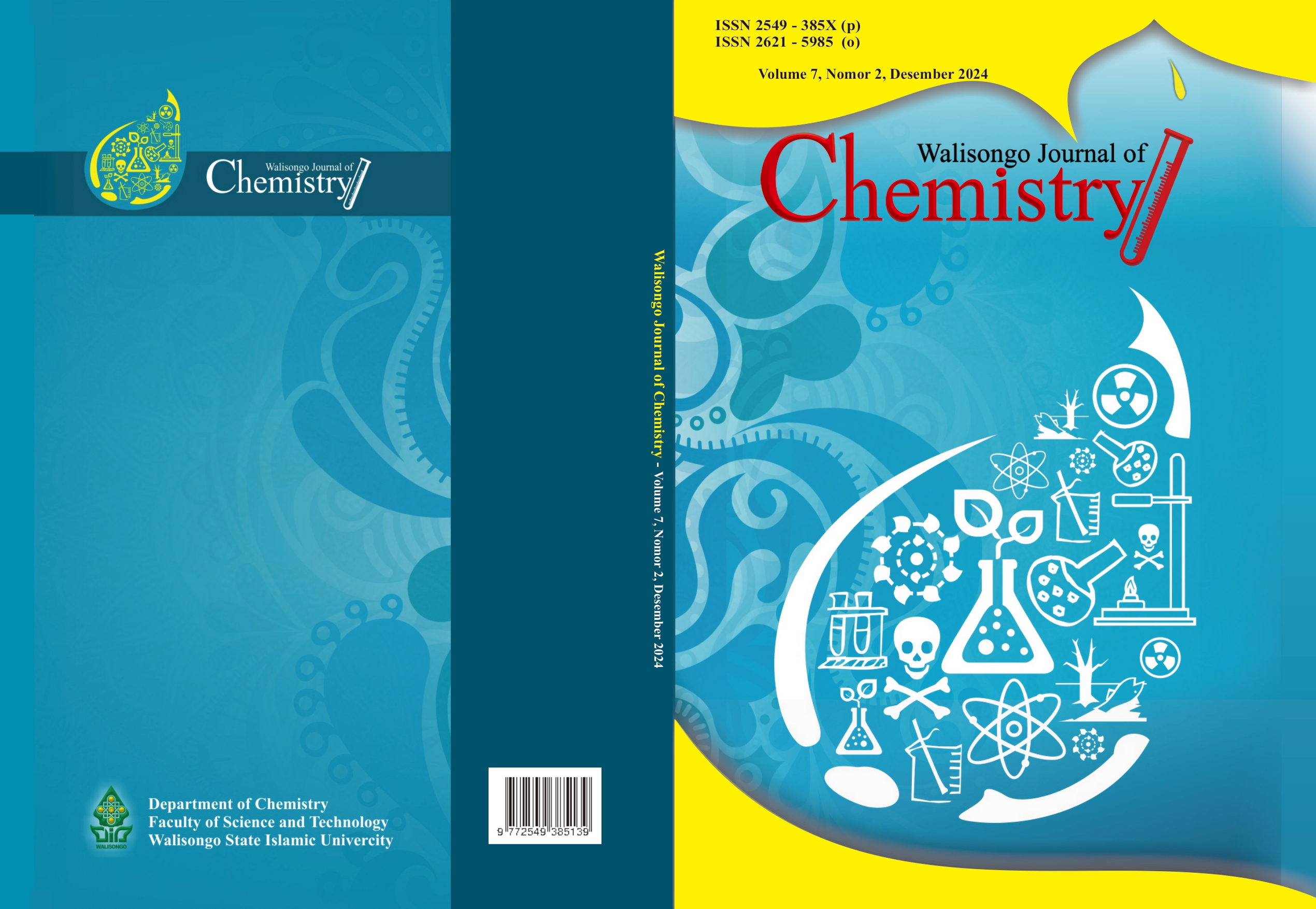Evaluation of Chemical and Nutrient Constituents of Cocoyam and Soybean Flours and Their Blends
DOI:
https://doi.org/10.21580/wjc.v7i2.20619Keywords:
Cocoyam (Colocasia esculenta), Soybean (Glycine max). Nutrients, carbohydrates, fats and proteinsAbstract
Food nutrients such as carbohydrates, fats, proteins and vitamins are essential for growth and development of man. Cocoyam (Colocasia esculenta), is a common tropical root crop cultivated in many parts of the world for food formulations and consumption by man. This study was conducted to assess some aspects of the chemical constituents and nutritive chemistry of cocoyam and soya bean flours and their blends.
The sun-dried samples were milled separately to size (sieve with 25µm aperture size) to obtain homogenous flours. Blends were obtained with various ratios according to the percentage of soybean/cocoyam flours (10% (10g: 90g), 20% (20:80), 30 %( 30:70), 40 %( 40:60), 50% (50:50). The proximate compositions (moisture, crude protein, crude fat, ash, crude fibre and nitrogen-free extract) were determined using standard methods. while mineral elements (Na and K) were determined by flame photometry and Mg, Ca, Fe, Zn and Cu by atomic absorption spectrophotometry (AAS). Results obtained were subjected to statistical analysis using Microsoft Excel for graphs, SPSS for correlation and regression studies. G-stat was used to calculate coefficient of variation. The ranges of values for the proximate composition (%) of the products were: Crude protein (4.95+1.03 – 43.29+0.46), ash (3.25+0.25 – 7.25+2.75), moisture (8.42+0.28-12.38+1.03), crude fibre (3.00+0.50 – 8.25+0.75) and nitrogen-free extract (10.60+ 7.34 - 76.02+1.83). Mineral elements(mg/kg): Fe (1.00+0.28 – 2.65+0.21), Zn (0.12+0.04 – 0.22+0.03), Cu (0.00+0.00 - 0.15+0.07), Na (0.35+0.05 – 2.40+0.14), Mg (3.45+0.43 – 12.88+0.55), Ca (4.80+0.42 -10.55+0.64), K (39.65+2.33 – 56.25+0.78) and phosphorus (206.10+ 0.05 – 326.34+4.30). Bleeding of cocoyam flour with soybean flour gave products that could be of greater nutritional value than either cocoyam or soybean flour used separately.
Downloads
References
Ajay, G. and Arvin, B. (2017). Genistein A multipurpose isoflavone. International Journal of Green Pharmacy. 3(s3):176-183. Anderson, J.W., Johnston, B.M. and Cook-Newell, M.E (1995). Meta-analysis of the effects of soy protein intake on serum lipids. N Engl J Med. 333(5):276-82p.
Anderson, J.W and Bush, H.M. (2014). Soy protein effects on serum lipoproteins: a quality assessment and meta-analysis of randomized, controlled studies. J Am Coll Nutrs. 30(2):79-91p.
Anon. (2014). Growing Cocoyam in Nigeria. International Institute for Tropical Agriculture. Commercial Crop Production Series. Available at: http:www,cassavabiz.org/agroenterpr.
AOAC. (2014). Official Methods of Analysis of AOAC, International. Association of Analytical
Chemists international, Gaithersburg, Maryland.
Barnes, S. (2017). The Biochemistry, Chemistry and Physiology of the Isoflavone in Soybeans and their Food Products. 8(1): 89—98p.
Braide, W. and Nwaoguikpe, R. N. (2011), Production of ethanol from cocoyam (Colocasia esculenta), International Journal of Plant Physiology and Biochemistry. 3(3): 64-65p.
Ekwe, K., Nwosu, K., Ekwe, C. and Nwachukwu, L. (2009). Examining the underexploited values of cocoyam (Colocasia and Xanthosoma spp.) for enhanced household food security, nutrition and economy in Nigeria.
Eleazu, C. O., Iroaganachi, M., and Eleazu, K. C. (2013) Ameliorative Potentials of cocoyam (Colocasia esculenta L.) and Unripe Plantain (Musa paradisiaca L.) on the relative tissue weights of streptozotocin-induced diabetic rats, Journal of Diabetes Research, pp.1-4. density in postmenopausal women. Menopause. 14(3 Pt. 1): 481—488p.
FAO/WHO (Food and Agriculture Organization of the United Nations/World Health Organization) (2019). Protein Quality Evaluation. Report of a joint FAO/WHO Expert Consultation. FAO Food and Nutrition paper 51.
Folade and Okafor. (2013). the granule size of cocoyam starch. Food Science Technology, 52 (6):3440-3448pp
Gundermann, K.J., Kuenker, A., Kuntz, E (2014). Activity of essential phospholipids (EPL) from soybean in liver diseases. Pharmacol Rep. 63(3):643-59p.
Ifemeje, J.C., Egbuna, C., Eziokwudiaso, J.O. and Ezebie, F.C. (2014). Determination of the Anti-nutrient composition of Ocimum gratissimum, Corchorus olitorius, Murraya koenigis spreng and Cucurbita maxima. Int. Journal Innov. Science, 3 (2): 127-133p.
Ihekoronye, A.I. and Ngoddy, P.O. (2018). Integrated Food Science and Technology for the tropics
Kuiper, G.G., Lemmen, J.G. and Carlsson, B. (2018). Interaction of estrogenic chemicals and phytoestrogens with estrogen receptor beta. Endocrinology. 139(10):4252-4263p.
Mandal, R.C. (2019). Tropical Roots and Tuber Crops. Agro Botanical Publishers. India. 392p.
Ogbemudia, Ruth, E. O., Nadozie, C. (2017). Asian Journal of Physical and Chemical of Sciences 4(3):1-6. DOI: 10.9734/AJOPACS/2017/38530.
Olomu, J.M. (2018). Monogastric Animal Nutrition. Jachem Publishers. Benin City. 3rd edition.153p.
Owusu-Darko, P. G., Paterson, A. and Omenyo, E. L. (2014), Cocoyam (corms and cormels) - An underexploited food and feed resource, Journal of Agricultural Chemistry and Environment. (3(1): 22-24p.
Oyenuga, Fetuga, B.L. (2005). Nigerian journal of science. 9(1):63-110p.
Salami, L. M. (2018).” If the scientists don’t know, how can I? Is it a case of too much information”? 206th Inaugural lecture of University of Benin, Benin City, Nigeria. 67p.
Sarkar, F.H., Li, Y. (2003). Soy isoflavones and cancer prevention. Cancer Invest. 21(5):744-757p.zz
Sizer and Whitney (2016). Nutrition concepts and controversies. 13thedition. USA: Brooks Cole.
Ukhun, M. E. and Ndiokwere, C. L. (2018). First Year University Organic Chemistry. Patcel Global Resources, Nigeria Ltd. 3rd edition. 260p.
USAD GRIN Taxonomy, 2015.
Downloads
Published
How to Cite
Issue
Section
License
Copyright (c) 2024 Walisongo Journal of Chemistry

This work is licensed under a Creative Commons Attribution-NonCommercial-ShareAlike 4.0 International License.
The copyright of the received article shall be assigned to the publisher of the journal. The intended copyright includes the right to publish the article in various forms (including reprints). The journal maintains the publishing rights to published articles.
In line with the license, authors and any users (readers and other researchers) are allowed to share and adapt the material. In addition, the material must be given appropriate credit, provided with a link to the license, and indicated if changes were made. If authors remix, transform or build upon the material, authors must distribute their contributions under the same license as the original.









